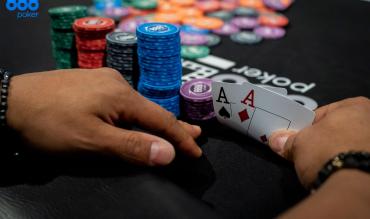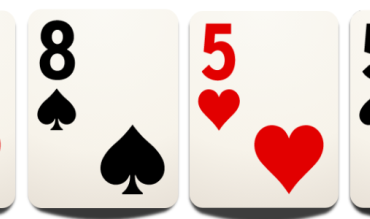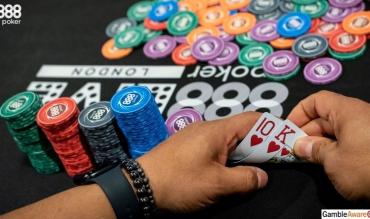Updated on May 26, 2025
Domination in poker occurs when a player has a significantly stronger hand than their opponent. Usually, a hand that relies on three outs or fewer to beat the other hand is dominated.
Understanding domination is crucial for making profitable decisions, especially in preflop scenarios.
Clear Examples of Dominated Hands
|
Dominant Hand |
Dominated Hand |
Equity Difference |
Notes |
|
AK |
AQ |
~70% vs 30% |
AK dominates AQ when an A or K flops |
|
KQ |
KJ |
~70% vs 30% |
When a K flops, KQ is significantly ahead |
|
99 |
88 |
~80% vs 20% |
88 has only two outs to win |
|
JJ |
JT |
~90% vs 10% |
JT is highly dominated since not even a T helps it |
Explanation of Domination
In Texas Hold’em, imagine we’re considering calling a preflop 4bet with KQs. Our opponent's range is QQ+/AK.
In this situation, we can consider our hand to be highly dominated. Unless we get fortunate, the strongest hand we will likely flop is one pair—Queens or Kings—any time we hit such a holding. However, there is a high possibility that our opponent has a better pair, i.e., they have us dominated.
If we flop a Queen, they might hold KK or AA. If we flop a King, they might hold KK or AK. We are not always behind since the villain might occasionally hold QQ when we flop a King.

However, the potential for domination is high in this example. The term reverse domination applies to scenarios where an otherwise inferior preflop holding makes the best hand by catching two pair.
For example:
- Hand 1: A♠️K♥️
- Hand 2: A♣️Q♥️
- Flop: A♦️Q♣️5♠️
Hand 1 was the best holding preflop, but the inferior AQ flopped two pair to take the lead. Thus, the AK is "reverse-dominated".
Other examples of heavily dominated hands include any weak draw. This might be a weak flush draw, the low end of a straight draw, or any draw on a board texture that already contains a pair.
Example of Domination used in a sentence: (Hold'em) I was reluctant to call the preflop 4bet with KQo because it suffers from domination issues.
Domination Poker Strategy
Domination can be a minor or major problem, depending on the situation. As a rough guide, domination in shallow-stacked scenarios is minor (or no issue), while domination in deeper-stacked scenarios can be crushing.
Domination, while deep-stacked, implies that we will incur significant reverse implied odds.
A big problem area for newer players is overplaying dominated draws, especially after misapplying pot odds.
Let's look at a No-Limit Hold'em example:
- Board: T♥️8♠️5♥️5♠️
- Hand: 6♥️7♥️

Let's imagine we are out of position on the turn, facing a half-pot bet from our opponent, while we both have relatively deep stacks.
Do we call or fold?
Of course, the decision depends on several variables, and we must consider all of them, but let’s focus on the cards.
We have fifteen outs to make either a straight or a flush by the river, meaning we'll hit roughly 30% of the time. We only need to hit 25% of the time, according to our pot odds, but there is a big problem here though:
All our outs are potentially dominated (sometimes called "tainted outs").
We might already be drawing dead to our opponent's possible full house. Even if we make our draw by the river, we should be concerned about losing poker chips value when our opponent value bets a better hand, i.e. reverse implied odds.
Despite getting the "correct price" after running a naïve pot odds calculation, we need more than the required pot odds for calling to be correct. We need a better price to compensate for our reverse implied odds on the river.
Of course, whether we should fold the poker hand in the example depends on the exact details of the situation. But it's not an automatic call, and either way, we should proceed with extreme caution.
Dominated Poker Draw
Here is another example of a dominated draw:
- Board: 6♠️7♣️8♣️
- Hand: A♥️5♥️
While it's true that we hold an open-ended straight draw, we should be careful about assuming that we have eight clean outs. A higher straight is possible, meaning we might already be drawing dead. If we hit one of our outs, the Nine, then any Ten has us dominated for the higher straight.

Also note that some of our straight outs are clubs, meaning that our opponent might make the flush while we make the straight.
Even if our straight ends up being good on the turn, our opponent will often have other redraw possibilities to make a flush or higher straight by the river.
Domination in Poker – FAQ
What hands are most often dominated in poker?
Stronger holdings like KQ, AQ, and AK frequently dominate middle-strength hands like KJ, QJ, and AJ. These hands perform poorly against typical raising ranges.
Why is domination more dangerous in deep-stacked poker?
In deep-stacked scenarios, dominated hands face significant reverse implied odds. You might hit your top pair only to lose a large pot to an opponent with the same top pair and a better kicker.
How do I avoid playing dominated hands?
Use GTO poker strategy to pay attention to position, preflop action, and opponent tendencies. Tighten your calling ranges against early position raises and against players who rarely bluff.
Can dominated hands still be profitable?
Yes, dominated hands can still be profitable in position, in multiway pots, and when stack depths are shallow. They also have value when making two pair or better types of hands.
How do I calculate domination risk?
Look at your opponent's likely poker hand range and count how many combinations in that range dominate your hand. The higher this percentage, the more cautious you should be.
Originally published on November 22, 2018
See Also
Implied odds, Reverse implied odds, Straight, Flush, Hand Rankings, Pair, Two pair, Drawing dead, Draw, Board, Pot odds


